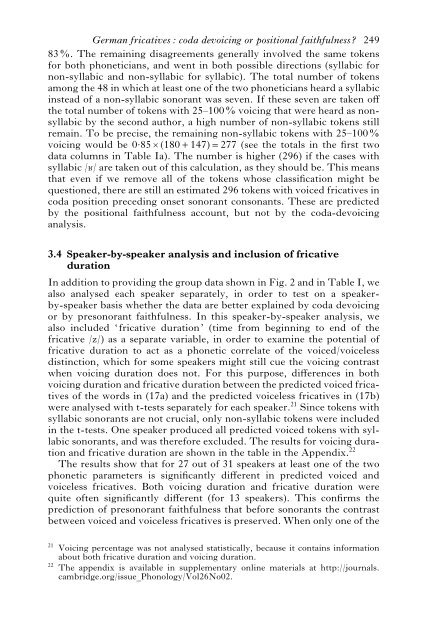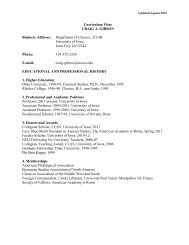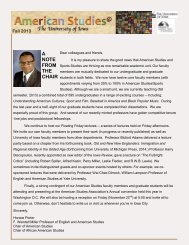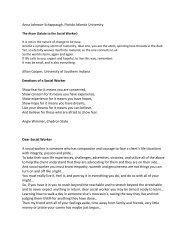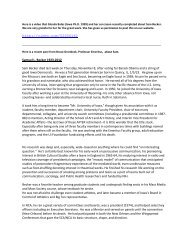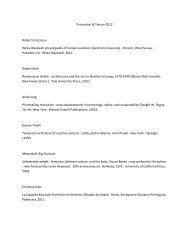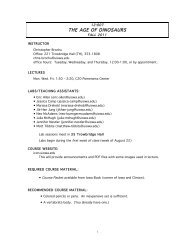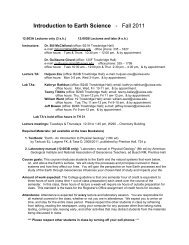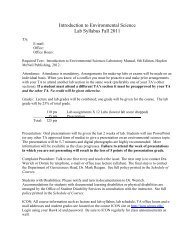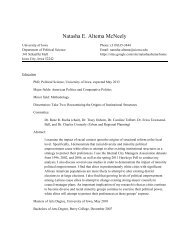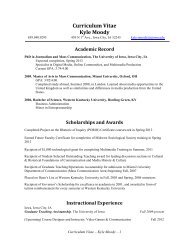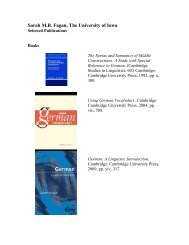German fricatives: coda devoicing or positional faithfulness?
German fricatives: coda devoicing or positional faithfulness?
German fricatives: coda devoicing or positional faithfulness?
You also want an ePaper? Increase the reach of your titles
YUMPU automatically turns print PDFs into web optimized ePapers that Google loves.
<strong>German</strong> <strong>fricatives</strong>: <strong>coda</strong> <strong>devoicing</strong> <strong>or</strong> <strong>positional</strong> <strong>faithfulness</strong>? 249<br />
83%. The remaining disagreements generally involved the same tokens<br />
f<strong>or</strong> both phoneticians, and went in both possible directions (syllabic f<strong>or</strong><br />
non-syllabic and non-syllabic f<strong>or</strong> syllabic). The total number of tokens<br />
among the 48 in which at least one of the two phoneticians heard a syllabic<br />
instead of a non-syllabic son<strong>or</strong>ant was seven. If these seven are taken off<br />
the total number of tokens with 25–100% voicing that were heard as nonsyllabic<br />
by the second auth<strong>or</strong>, a high number of non-syllabic tokens still<br />
remain. To be precise, the remaining non-syllabic tokens with 25–100%<br />
voicing would be 0 . 85X(180+147)=277 (see the totals in the first two<br />
data columns in Table Ia). The number is higher (296) if the cases with<br />
syllabic /H/ are taken out of this calculation, as they should be. This means<br />
that even if we remove all of the tokens whose classification might be<br />
questioned, there are still an estimated 296 tokens with voiced <strong>fricatives</strong> in<br />
<strong>coda</strong> position preceding onset son<strong>or</strong>ant consonants. These are predicted<br />
by the <strong>positional</strong> <strong>faithfulness</strong> account, but not by the <strong>coda</strong>-<strong>devoicing</strong><br />
analysis.<br />
3.4 Speaker-by-speaker analysis and inclusion of fricative<br />
duration<br />
In addition to providing the group data shown in Fig. 2 and in Table I, we<br />
also analysed each speaker separately, in <strong>or</strong>der to test on a speakerby-speaker<br />
basis whether the data are better explained by <strong>coda</strong> <strong>devoicing</strong><br />
<strong>or</strong> by preson<strong>or</strong>ant <strong>faithfulness</strong>. In this speaker-by-speaker analysis, we<br />
also included ‘fricative duration’ (time from beginning to end of the<br />
fricative /z/) as a separate variable, in <strong>or</strong>der to examine the potential of<br />
fricative duration to act as a phonetic c<strong>or</strong>relate of the voiced/voiceless<br />
distinction, which f<strong>or</strong> some speakers might still cue the voicing contrast<br />
when voicing duration does not. F<strong>or</strong> this purpose, differences in both<br />
voicing duration and fricative duration between the predicted voiced <strong>fricatives</strong><br />
of the w<strong>or</strong>ds in (17a) and the predicted voiceless <strong>fricatives</strong> in (17b)<br />
were analysed with t-tests separately f<strong>or</strong> each speaker.21 Since tokens with<br />
syllabic son<strong>or</strong>ants are not crucial, only non-syllabic tokens were included<br />
in the t-tests. One speaker produced all predicted voiced tokens with syllabic<br />
son<strong>or</strong>ants, and was theref<strong>or</strong>e excluded. The results f<strong>or</strong> voicing duration<br />
and fricative duration are shown in the table in the Appendix.22<br />
The results show that f<strong>or</strong> 27 out of 31 speakers at least one of the two<br />
phonetic parameters is significantly different in predicted voiced and<br />
voiceless <strong>fricatives</strong>. Both voicing duration and fricative duration were<br />
quite often significantly different (f<strong>or</strong> 13 speakers). This confirms the<br />
prediction of preson<strong>or</strong>ant <strong>faithfulness</strong> that bef<strong>or</strong>e son<strong>or</strong>ants the contrast<br />
between voiced and voiceless <strong>fricatives</strong> is preserved. When only one of the<br />
21 Voicing percentage was not analysed statistically, because it contains inf<strong>or</strong>mation<br />
about both fricative duration and voicing duration.<br />
22 The appendix is available in supplementary online materials at http://journals.<br />
cambridge.<strong>or</strong>g/issue_Phonology/Vol26No02.


